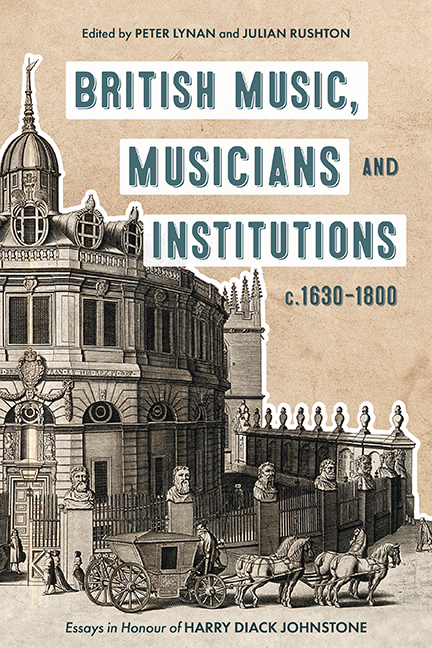Book contents
- Frontmatter
- Contents
- List of Illustrations
- List of Music Examples
- List of Contributors
- Acknowledgements
- List of Abbreviations
- Note to the Reader
- Introduction
- Part I Performers and Performance Style
- Part II Composers and Secular Institutions
- Part III Sacred Music and Institutions
- Part IV Dissemination: Copying, Printing, and Publishing
- Epilogue: Musica Britannica and the Eighteenth Century
- Harry Diack Johnstone: A Tribute
- Bibliography of the Publications of Harry Diack Johnstone
- Index
- Tabula Gratulatoria
13 - The Earliest Surviving Engraved Music Plates?
Published online by Cambridge University Press: 06 October 2022
- Frontmatter
- Contents
- List of Illustrations
- List of Music Examples
- List of Contributors
- Acknowledgements
- List of Abbreviations
- Note to the Reader
- Introduction
- Part I Performers and Performance Style
- Part II Composers and Secular Institutions
- Part III Sacred Music and Institutions
- Part IV Dissemination: Copying, Printing, and Publishing
- Epilogue: Musica Britannica and the Eighteenth Century
- Harry Diack Johnstone: A Tribute
- Bibliography of the Publications of Harry Diack Johnstone
- Index
- Tabula Gratulatoria
Summary
Although printing music from movable type was the predominant method employed for nearly two hundred years after Ottaviano Petrucci's pioneering work at the opening of the sixteenth century, occasional use of engraving did occur at intervals during this period, beginning in the 1530s with Francesco da Milano's Intabolatura da leuto (c.1535). The technique of engraving copper plates had been in use for reproducing works of art from the mid-fifteenth century and was soon extended to maps and the like, so there was nothing problematic in printing music by this method. The most immediate advantage was that any type of music could be accommodated, so it is not surprising that lute music and keyboard music were the two genres that first made use of it; although it was possible to print such music typographically, the result was rarely elegant. Parthenia (1612/13), described on the title-page as ‘the first musicke that ever was printed for the virginalls’ and engraved by William Hole, marked the appearance of engraved music in England. It was, however, only in the closing decades of the seventeenth century that engraved music came to the fore. One reason for its slow adoption was that copper plates were comparatively expensive, and the hardness of the metal also made it slow to engrave. While this was of minor consequence for single-plate works of art or maps, a music publication with several dozen pages was a different matter. According to Sir John Hawkins, Estienne Roger in Amsterdam around the end of the seventeenth century found that a softer amalgam of copper could make life easier for the engraver, but the real breakthrough came with the discovery about the same time that pewter offered a satisfactory alternative to copper: cheaper and more easily engraved, yet resilient enough to withstand the stresses of a rolling press. Thomas Cross and John Walsh the elder were among the first to adopt it in England, and while the former remained faithful to engraving everything by hand with a graver, the latter embraced an important second innovation, the use of a series of punches to provide the note heads, clefs, dynamic signs, and text, which eased much of the work. This gradually became general practice in the eighteenth century, and it then remained an essentially unchanged method at least of producing the master copy of a page of music until well into the second half of the twentieth century.
- Type
- Chapter
- Information
- British Music, Musicians and Institutions, c. 1630-1800Essays in Honour of Harry Diack Johnstone, pp. 240 - 262Publisher: Boydell & BrewerPrint publication year: 2022



